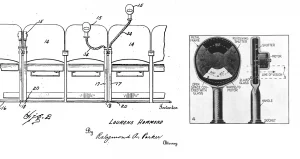Laurens Hammond, the inventor of the Hammond Organ, was born in Evanston, Illinois, in 1895. In 1897, Hammond’s father died and his mother, Idea Hammond, moved all four kids to Europe, where they moved around between England, France, and Germany. While in Europe, Hammond began to dabble in engineering and invention. In 1907 at the age of 12, Hammond filed a patent in France for an automatic gearshift for automobiles. Hammond and his mother pitched the invention to Panhard, a French automaker. Although Panhard turned him down, the company’s chief engineer explained to Hammond that the invention was technically and theoretically sound, but the material requirements were not practical. This began Hammond’s career as an inventor, in which he would hold more than 100 patents.
In 1912 – three years after moving with his family back to Evanston, Illinois – Hammond filed a patent for a low-cost differential mercurial barometer. While the barometer did not have broad applications, it would be Hammond’s first commercially successful invention. In 1916, Hammond graduated from Cornell University with honors and enlisted in the Army when the U.S. joined World War I. During the war, Hammond served in an engineering regiment and would reach the rank of Captain.
Hammond’s Early Inventions
After the war, Hammond took a job as the chief engineer at Gray Motor Company, a manufacturer of marine engines. This position allowed Hammond to further develop his engineering skills and provided him with a workshop in which he could tinker and develop ideas and work on side projects. In 1919, Hammond filed a patent for a silent, “tick-less” clock that housed a spring motor inside of a soundproof casing. The design created enough interest from manufacturers that Hammond moved to New York City to further develop his clock and other ideas.
One of these other ideas was Teleview, an early system for projecting and viewing 3D films. Teleview was the first system that utilized alternate-frame sequencing to create stereoscopic 3D projections. The system worked by flashing left-eye and right-eye frames from separate projectors at a precise and constant rate. Viewing devices – analogous to 3D glasses – were attached to theater seats and had shutters that opened and closed synchronously with the projectors – blocking the viewer’s left eye when the right-eye frames flashed, and vice-versa. Very much like his automatic gearshift, the Teleview system was technically sound, and the one test film was met with critical acclaim, the machinery and specialty viewing devices were not practical. However, while Teleview may not have been a success, Hammond was able to develop the expertise in the design and building of synchronous motors that would be utilized in his most successful inventions.
stereoscopic 3D projections. The system worked by flashing left-eye and right-eye frames from separate projectors at a precise and constant rate. Viewing devices – analogous to 3D glasses – were attached to theater seats and had shutters that opened and closed synchronously with the projectors – blocking the viewer’s left eye when the right-eye frames flashed, and vice-versa. Very much like his automatic gearshift, the Teleview system was technically sound, and the one test film was met with critical acclaim, the machinery and specialty viewing devices were not practical. However, while Teleview may not have been a success, Hammond was able to develop the expertise in the design and building of synchronous motors that would be utilized in his most successful inventions.
The Hammond Clock Company
In 1928, after perfecting his design and patenting a new alternating-current clock, the inventor launched the Hammond Clock Company. The clock utilized a synchronous motor, whose speed was tied to the frequency of the current supplied by the power grid. Essentially, the motor would run at the same speed indefinitely if it had power from the grid. The Hammond Clock Company was a major success, manufacturing 100s of different clock models itself, while at the same time licensing the patent to over 100 different clock manufacturers.
motor, whose speed was tied to the frequency of the current supplied by the power grid. Essentially, the motor would run at the same speed indefinitely if it had power from the grid. The Hammond Clock Company was a major success, manufacturing 100s of different clock models itself, while at the same time licensing the patent to over 100 different clock manufacturers.
In the initial stages of the Great Depression, the Hammond Clock Company continued to be a major success. This was mostly due to major simplifications that Hammond made to the manufacturing process, which mostly required unskilled labor. However, in 1932, it was discovered that the main town clock in Cologne, Germany was built using a synchronous electric motor in 1895. This clock was quickly replaced as the erratic current from the 1895 German power grid caused interruptions in the function of the motor. However, because the clock was built, it constituted a publication of the invention, which invalidated Hammond’s patent.
The Hammond Electric Bridge Table
The Hammond Clock Company continued to operate, but the licensing fees disappeared overnight. In 1932, the company employed more than 700 people, and Hammond was under intense pressure to protect their jobs during the largest economic downturn in U.S. history. Thus, Hammond set about developing several different products for the company to sell. The first was the Hammond Electric Bridge Table. The table had a built-in mechanism that shuffled and dealt the cards automatically, giving a set of randomly picked bridge hands of four 13-card sets to each of the four players. The bridge table was a success, saving the company from folding in 1932, but it was a short-term success and sales fell off within several years.
under intense pressure to protect their jobs during the largest economic downturn in U.S. history. Thus, Hammond set about developing several different products for the company to sell. The first was the Hammond Electric Bridge Table. The table had a built-in mechanism that shuffled and dealt the cards automatically, giving a set of randomly picked bridge hands of four 13-card sets to each of the four players. The bridge table was a success, saving the company from folding in 1932, but it was a short-term success and sales fell off within several years.
In 1934, with the sales of the bridge table dwindling, it looked like the company was fated to fold. Hammond then patented what would be his greatest invention – the Hammond Organ.









I was drawn to the sound of the Hammond organ when I was twelve years old and found the tone of the Hammond fascinating. When I became aware of the whole tonewheet device, I was even more fascinated. Truly a marvel of engineering.
Many of the black churches embrace the Hammond Organ. It expresses true essence on a spiritual level of worship. Laurens Hammond was a true Genius to create such an awesome instrument! Truly way ahead of his time. Hammond Organ is more popular today than it was when I was first created. They try to duplicate that sound, but nothing comes close to the true richness of the Hammond sound. God bless Lauren Hammond!